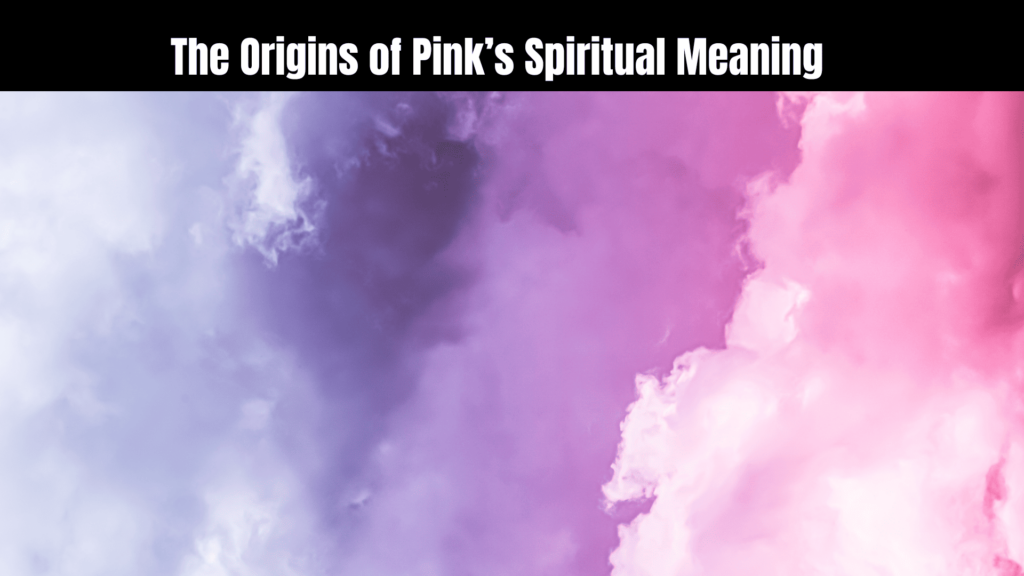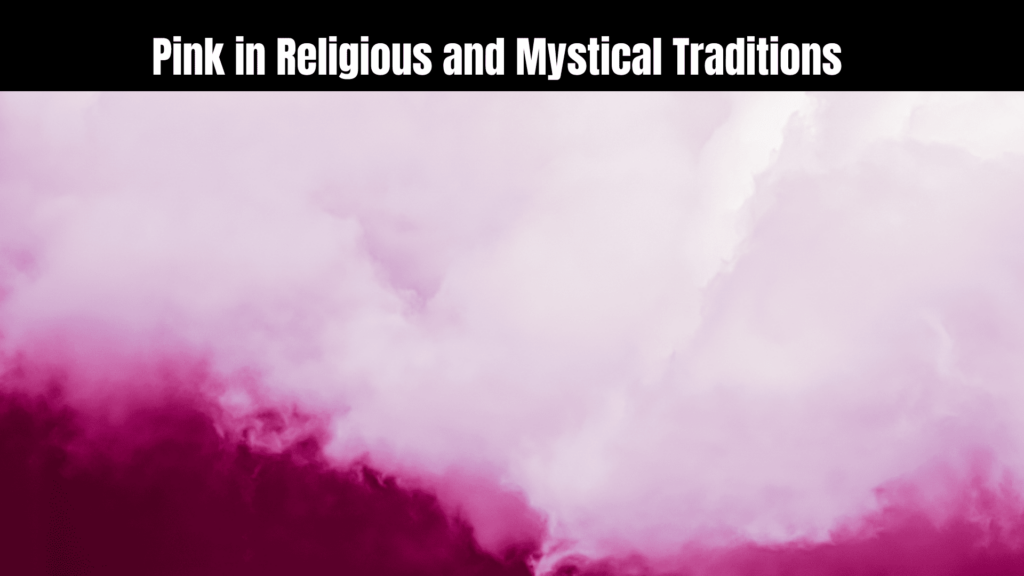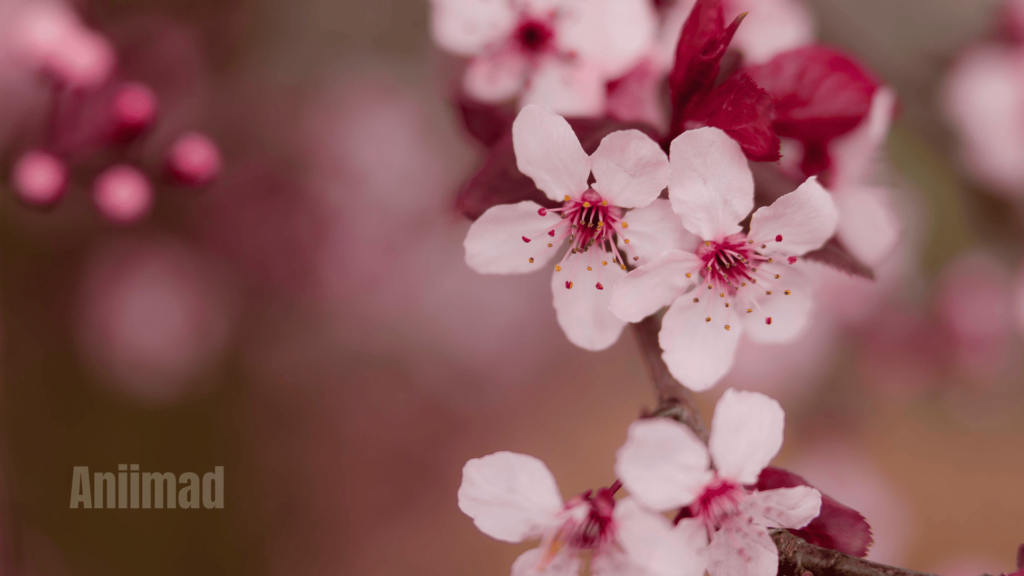The Spiritual Meaning of Pink
Introduction to the Spiritual Significance of Colors
Colors have long been revered for their spiritual significance. Each shade carries unique vibrations, impacting our emotions, energy, and consciousness. Among these, pink stands out as a color of love, serenity, and compassion. Let us explore the depth of its spiritual meaning.
The Origins of Pink’s Spiritual Meaning

The spiritual meaning of pink has evolved through centuries, deeply rooted in historical, cultural, and symbolic contexts. This gentle and vibrant hue has always been associated with emotions and qualities that foster connection, love, and harmony. Understanding the origins of pink’s spiritual meaning requires a look into its historical use, cultural significance, and emotional resonance.
Pink in Historical and Cultural Contexts
In ancient civilizations, pink was often derived from natural pigments found in minerals and flowers. Its presence in art and decoration reflected beauty and refinement. While ancient cultures did not explicitly identify pink as a separate color, its soft tones were frequently used to symbolize the transition between the passionate energy of red and the calm purity of white.
In European art and fashion during the 18th century, pink became a color associated with luxury and sophistication. Aristocrats adorned themselves with pink garments, linking it to elegance and charm. Over time, pink grew into a universal representation of love and affection.
How Pink Became Symbolic of Love and Compassion
The symbolic association of pink with love and compassion stems from its visual and emotional characteristics. Pink inherits the fiery passion of red but tempers it with the gentleness of white. This balance makes pink a color that radiates care and tenderness rather than intense energy.
In the spiritual realm, pink is seen as a representation of unconditional love—the kind that transcends material concerns and connects with the soul. This symbolism is particularly evident in spiritual practices such as meditation, where pink visualizations are used to evoke a sense of warmth and self-acceptance.
Cultural Symbolism Across Traditions
Pink holds varied meanings across cultures. For instance:
- In Eastern traditions, pink often symbolizes renewal and rejuvenation. Its delicate tone is associated with spring blossoms, representing hope and the cyclical nature of life.
- In Western spirituality, pink is linked to divine love and compassion. It is often used in religious imagery to depict the gentle and nurturing aspects of divinity.
- Indigenous cultures have also embraced pink through natural elements, using it to symbolize balance and harmony with the Earth.
The Evolution of Pink’s Meaning Over Time
As society progressed, pink’s meaning expanded to include aspects of emotional healing and spiritual growth. In the 20th century, the association of pink with gender roles—particularly femininity—reinforced its connection to nurturing, care, and emotional depth. However, modern interpretations of pink emphasize its universal qualities, transcending gender to represent self-love, empathy, and compassion for others.
Core Spiritual Associations of Pink

The color pink holds a profound and multifaceted spiritual significance, deeply intertwined with concepts of love, compassion, and harmony. It is a color that evokes gentle emotions and fosters connections between the physical and spiritual realms. Let’s explore the core spiritual associations of pink and how they influence both personal growth and collective consciousness.
1. Unconditional Love and Compassion
Pink is universally recognized as the color of unconditional love. It symbolizes the deep, nurturing love that transcends material and physical boundaries, embodying kindness and empathy. This association is often linked to spiritual practices where pink energy is used to open the heart chakra, encouraging emotional healing and forgiveness.
- In Meditation: Visualizing pink light is a common technique to cultivate compassion and heal emotional wounds.
- In Relationships: Pink energy fosters understanding, acceptance, and harmony, making it a cornerstone for building meaningful connections.
2. Emotional Healing
The soft and soothing hue of pink is believed to have a calming effect on the mind and body. Spiritually, it promotes emotional stability and helps in releasing negative emotions like anger, resentment, and fear.
- Healing Properties: Pink is associated with self-care and emotional rejuvenation, acting as a balm for the soul during times of stress or grief.
- Chakra Alignment: It is often linked to the heart chakra, facilitating a free flow of positive emotions.
3. Inner Peace and Harmony
Pink’s gentle energy resonates with tranquility and balance. It encourages introspection and self-acceptance, helping individuals align their inner and outer worlds.
- Spiritual Practices: Using pink candles, crystals, or fabrics in sacred spaces can enhance feelings of peace and unity.
- Mindfulness: Pink serves as a reminder to pause, reflect, and embrace life with an open heart.
4. Feminine Energy and Nurturing
Pink embodies the essence of divine feminine energy, which represents intuition, creativity, and nurturing qualities. This spiritual association highlights the importance of compassion, care, and emotional resilience.
- Yin Energy: Pink is aligned with the yin aspect in Eastern philosophy, symbolizing receptivity and the nurturing side of existence.
- Motherhood and Caregiving: Spiritually, pink represents the unconditional love of a mother, making it a color of protection and comfort.
5. Hope and Renewal
Spiritually, pink is a color of renewal and hope. It signifies new beginnings, fresh perspectives, and the healing power of love. This makes it a powerful color in rituals and ceremonies focused on transformation.
- Spring Symbolism: In many cultures, pink is associated with the blooming of flowers in spring, symbolizing growth and rebirth.
- Affirmations and Intentions: Incorporating pink into affirmations helps set intentions rooted in love and positivity.
6. Universal Connection
Pink transcends the individual and connects with collective consciousness. It serves as a reminder of our shared humanity and the importance of kindness in our interactions.
- Community Energy: Pink represents the energy of compassion and understanding that unites people.
- Global Love: It embodies the ideal of universal love, breaking down barriers and fostering inclusivity.
Crystals and Symbols Associated with Pink
Certain crystals, flowers, and symbols are spiritually linked to pink and enhance its energy:
- Crystals: Rose quartz, pink tourmaline, and rhodonite are popular stones that amplify pink’s loving vibrations.
- Flowers: Pink roses, cherry blossoms, and peonies symbolize tenderness and the fleeting beauty of life.
- Sacred Symbols: The lotus flower, often depicted in pink, represents spiritual awakening and purity.
Pink in Religious and Mystical Traditions

The color pink has profound significance in various religious and mystical traditions, representing love, compassion, and divine connection. Across cultures and belief systems, pink is often used as a symbol of spiritual harmony, emotional healing, and a bridge between the earthly and divine realms. Let’s explore how pink is revered and utilized in different spiritual and mystical practices.
1. Pink in Christianity: Divine Love and Compassion
In Christian tradition, pink is often associated with joy, love, and compassion. It is used liturgically during specific periods to signify hope and renewal.
- Liturgical Use: Pink is prominently displayed during the third Sunday of Advent (Gaudete Sunday) and the fourth Sunday of Lent (Laetare Sunday). These days focus on joy and the anticipation of Christ’s love and resurrection.
- Symbol of Divine Love: Pink represents the tender and unconditional love of God, embodying care, forgiveness, and nurturing.
2. Pink in Buddhism: Loving-Kindness and Enlightenment
In Buddhist traditions, pink is associated with metta (loving-kindness) and compassion, central tenets of Buddhist philosophy.
- The Lotus Flower: The pink lotus is a significant symbol in Buddhism, representing the ultimate state of enlightenment and the purity of the mind. It is considered the highest lotus color, symbolizing divine understanding.
- Meditative Practices: Visualizing pink light or petals is used in meditation to cultivate loving-kindness towards oneself and others.
3. Pink in Hinduism: Harmony and Spiritual Devotion
In Hindu culture, pink holds a sacred place, symbolizing harmony, affection, and spiritual devotion.
- Festivals and Celebrations: Pink flowers such as the lotus are frequently offered in prayers and rituals, representing purity and divine connection.
- Goddess Worship: Pink is often associated with feminine deities like Lakshmi, the goddess of prosperity and love, and Saraswati, the goddess of wisdom.
4. Mystical Interpretations of Pink in Energy Work
Pink plays a vital role in energy healing and mystical practices, particularly in the realms of aura reading, chakras, and vibrational healing.
- Heart Chakra Activation: Pink is closely linked to the heart chakra, which governs love, compassion, and emotional balance. It is believed that visualizing pink energy can open and heal the heart chakra, fostering self-love and forgiveness.
- Auras: A pink aura is often seen as a sign of a loving, compassionate, and emotionally open individual. It indicates harmony and a nurturing spirit.
- Crystals and Healing: Pink gemstones like rose quartz and rhodonite are widely used in spiritual practices to amplify loving and healing energies.
5. Pink in Islamic Mysticism: Beauty and Love
Although pink is not explicitly discussed in Islamic scripture, its connection to beauty and love aligns with themes in Islamic mysticism (Sufism).
- Sufi Symbolism: In Sufi poetry and art, pink is often associated with divine love and beauty, reflecting a deep spiritual connection to the Creator.
- Roses in Islam: The pink rose is a recurring motif, symbolizing love for God and the Prophet Muhammad.
6. Pink in Indigenous and Shamanic Practices
Many indigenous and shamanic traditions incorporate pink through natural elements, emphasizing balance, harmony, and spiritual renewal.
- Nature’s Role: Pink flowers, sunsets, and stones are considered sacred, embodying the nurturing and restorative qualities of the Earth.
- Ceremonial Use: Pink is often present in rituals aimed at healing relationships, invoking love, or restoring emotional balance.
7. Pink in Mysticism and Esoteric Practices
In esoteric traditions, pink represents higher vibrations of love, compassion, and divine feminine energy.
- Alchemy and Symbolism: Alchemical texts often use pink to represent the rubedo stage, symbolizing the culmination of spiritual transformation and enlightenment.
- Divine Feminine Energy: Pink is seen as a representation of the divine feminine, encompassing intuition, nurturing, and creation.
8. The Universal Mystical Message of Pink
Across all traditions, pink serves as a reminder of the interconnectedness of love, compassion, and spiritual growth. It transcends cultural and religious boundaries, resonating with universal themes of care and unity.
Psychological and Emotional Impacts of Pink
The color pink carries profound psychological and emotional connotations, making it one of the most impactful hues in influencing human behavior and feelings. Often associated with love, kindness, and nurturing, pink has a unique ability to evoke emotions ranging from calmness to excitement, depending on its shade and intensity. Let’s delve into the psychological and emotional impacts of pink, exploring its influence on the mind, behavior, and overall mood.
1. Pink as a Soothing and Calming Color
Pink is widely regarded as a calming color with the power to reduce tension and promote relaxation.
- Stress Reduction: Soft shades of pink are known to alleviate feelings of anger and anxiety. Studies show that exposure to pink environments can lower heart rates and create a sense of tranquility.
- Anger Management: The “Baker-Miller Pink” experiment demonstrated that certain shades of pink can reduce aggression in individuals, making it a popular choice in detention centers and therapy rooms.
2. The Nurturing and Comforting Effect
Pink evokes a sense of care, compassion, and warmth, making it a nurturing color that promotes emotional well-being.
- Association with Love and Affection: Pink is often linked to maternal love and tenderness, fostering feelings of being cared for and cherished.
- Childhood Connection: The color is frequently associated with innocence and childhood, reinforcing a sense of safety and comfort.
3. Pink and Positive Emotional Stimuli
Pink has the ability to generate positive emotions and boost overall mood.
- Happiness and Optimism: Bright and vibrant shades of pink, such as fuchsia, exude energy and enthusiasm, sparking joy and positivity.
- Romantic Associations: As a symbol of romantic love, pink stimulates feelings of connection, attraction, and emotional intimacy.
4. The Feminine and Gendered Aspect of Pink
Culturally, pink has often been linked to femininity, shaping societal perceptions and expectations.
- Empowerment through Femininity: While pink is traditionally associated with women, it is increasingly seen as a color of empowerment and confidence, challenging outdated gender norms.
- Modern Gender Neutrality: Pink’s psychological impact transcends gender, and its calming and loving qualities make it appealing to people of all identities.
5. Psychological Impacts of Shades of Pink
The emotional and psychological influence of pink can vary significantly depending on its hue and intensity:
- Light Pink: Evokes calmness, tenderness, and emotional healing, making it ideal for environments requiring peace and relaxation.
- Hot Pink: A more energetic and stimulating shade, it represents excitement, boldness, and youthful vibrancy.
- Muted Pink: Promotes thoughtfulness, introspection, and subtle sophistication, often used in professional or minimalistic settings.
6. Pink in Therapy and Healing Practices
Pink is often utilized in psychological and therapeutic practices due to its profound emotional influence.
- Color Therapy (Chromotherapy): Pink is used to encourage emotional healing, foster self-love, and combat feelings of isolation or sadness.
- Trauma Recovery: Soft pink tones are incorporated in therapy spaces to create a safe and non-threatening environment for emotional recovery.
7. Cultural Interpretations of Pink’s Emotional Impact
Different cultures perceive and experience the emotional impacts of pink in unique ways:
- Western Cultures: Pink is associated with love, romance, and femininity.
- Eastern Cultures: In Japan, pink symbolizes youth and the beauty of fleeting moments, often linked to cherry blossoms.
- Global Shifts: Increasingly, pink is being redefined as a color of empowerment and inclusivity, transcending traditional roles.
8. Negative Associations with Pink
While pink is predominantly seen as a positive color, it can also carry certain negative connotations:
- Overuse and Fatigue: Overwhelming use of pink can lead to overstimulation or evoke feelings of immaturity.
- Stereotyping: In some contexts, pink is seen as overly feminine or frivolous, which may alienate individuals who prefer more neutral or bold colors.
9. Pink in Marketing and Branding
Brands often leverage pink’s emotional and psychological associations to connect with their audience.
- Nurturing Brands: Pink is commonly used by brands targeting children, women, or families to evoke trust and care.
- Bold Statements: Hot pink is used to make bold, attention-grabbing statements, often associated with youth and fun.
The Role of Pink in Chakras and Energy Work

In the world of energy work, color plays a significant role in influencing and balancing the body’s energy centers, known as chakras. While pink is not traditionally associated with one of the main seven chakras, its presence and influence in the energy system are powerful. The color pink is believed to align with several aspects of spiritual and emotional well-being, particularly when it comes to love, compassion, and healing. This article will explore the role of pink in chakras and energy work, shedding light on its connection to the heart chakra and its broader impact on the energy field.
1. Pink’s Connection to the Heart Chakra
The Heart Chakra, or Anahata, is the fourth energy center in the body and governs love, compassion, and emotional balance. While the Heart Chakra is traditionally associated with the color green, pink is often considered its complementary color, embodying the softer and more nurturing aspects of love.
- Emotional Healing: Pink energy works on an emotional level to heal the heart, fostering forgiveness, emotional release, and compassion. It can support individuals in overcoming past traumas, encouraging openness and self-love.
- Balancing Love and Relationships: When the Heart Chakra is out of balance, individuals may experience feelings of isolation or difficulty in expressing love. Pink energy helps restore balance by promoting harmonious relationships and emotional connection with others.
- Nurturing and Self-Care: Pink is deeply associated with the gentle, nurturing side of love, making it an ideal color for practices aimed at self-compassion and healing. It encourages the act of caring for oneself and others, promoting a sense of warmth and safety.
2. The Role of Pink in the Crown Chakra
Though the Crown Chakra, or Sahasrara, is primarily linked to the color violet or white, the soft hues of pink are also considered to play a role in spiritual enlightenment and connection to the divine.
- Spiritual Love and Universal Compassion: Pink in the Crown Chakra enhances the ability to experience unconditional love and compassion at a universal level. It encourages individuals to open their hearts not just to themselves but to all beings, creating a connection to the greater spiritual consciousness.
- Accessing Divine Love: This energy facilitates a deeper connection to divine love, helping individuals access higher realms of consciousness and embrace the interconnectedness of all life.
3. Pink in Energy Healing Practices
In various energy healing practices, pink is used to bring healing to both the physical and emotional bodies. Its soothing, loving qualities make it a potent tool for practitioners working to restore balance and harmony.
- Crystal Healing: Pink crystals, such as Rose Quartz, are often used in energy healing to restore the balance of the Heart Chakra and promote emotional healing. Rose Quartz is known for its ability to encourage self-love, compassion, and emotional forgiveness.
- Aura Cleansing: Pink energy is frequently employed in aura cleansing practices. It is said to strengthen the energy field and eliminate emotional blockages, creating an aura of love and positivity around the individual.
- Reiki Healing: Practitioners of Reiki often work with pink light during sessions to channel healing energy into the Heart Chakra, promoting deep emotional healing and love-based energy.
4. The Healing Power of Pink in Meditation
Meditation practices that incorporate the color pink often focus on nurturing, emotional healing, and heart-opening exercises. By visualizing pink light or using pink-colored objects, individuals can align their energy centers and invoke a sense of peace and emotional well-being.
- Heart-Centered Meditation: In heart-centered meditation, practitioners focus on the energy of the Heart Chakra, visualizing pink light emanating from their chest to create feelings of love, forgiveness, and peace. This type of meditation can help alleviate emotional blockages and promote healing.
- Mantras and Affirmations: Integrating pink energy with positive affirmations, such as “I am love” or “I am open to giving and receiving love,” amplifies the healing process by reinforcing self-love and compassion.
- Relaxation and Stress Relief: Pink can also aid in relaxation, as it calms the nervous system and encourages a balanced, gentle approach to life. It’s especially beneficial in meditations focused on releasing stress, anxiety, or emotional turmoil.
5. How Pink Energy Can Enhance Emotional Intelligence
Pink’s influence extends beyond the physical body and emotional healing—it also has a profound effect on emotional intelligence. Emotional intelligence refers to the ability to identify, understand, and manage one’s emotions, as well as the emotions of others. Pink energy, with its focus on love and compassion, plays a crucial role in developing these skills.
- Self-Awareness: Pink can help individuals develop a stronger sense of self-awareness by encouraging them to acknowledge their emotional needs and desires. This self-understanding fosters emotional maturity and deeper empathy for others.
- Empathy and Compassion: As a color that embodies compassion, pink energy enhances the ability to empathize with others, creating deeper, more meaningful connections. By fostering kindness and understanding, it helps individuals improve their relationships and social dynamics.
- Emotional Balance: Pink energy promotes emotional balance by encouraging individuals to release negative emotions, such as resentment or anger, and embrace love and forgiveness. This energy assists in navigating difficult emotions with grace and compassion.
6. The Symbolism of Pink in Energy Work: Love and Healing
Throughout various energy work practices, pink consistently symbolizes love, healing, and compassion. Its gentle frequency is regarded as one of the most healing and transformative forces in the energy field.
- Love as the Foundation of Healing: Pink represents the energy of love in all its forms—self-love, unconditional love, and healing love. It encourages individuals to approach themselves and others with kindness and compassion, facilitating emotional and spiritual growth.
- Healing from Trauma: For those experiencing emotional wounds or trauma, pink energy serves as a nurturing balm, gently encouraging the release of pain and the acceptance of healing. Its comforting and non-judgmental nature creates a safe space for healing to occur.
Pink in Daily Spiritual Practices

Incorporating the color pink into daily spiritual practices can have a profound impact on one’s emotional and spiritual well-being. From meditation to prayer, pink energy encourages a loving, compassionate, and healing atmosphere. It fosters a sense of inner peace, nurturing, and connection with higher states of consciousness. This article will explore various ways in which pink can be woven into daily spiritual routines, offering a deeper connection to love, healing, and self-care.
1. Integrating Pink into Meditation Practices
Meditation is one of the most powerful spiritual practices where color visualization can enhance the experience and outcomes. Pink, being a color that represents unconditional love and compassion, can be effectively used to open and balance the Heart Chakra, promoting emotional healing and spiritual growth.
- Heart-Centered Meditation: One of the most common ways to incorporate pink into meditation is through heart-centered practices. During meditation, visualize a soft, pink light glowing in your chest area, slowly expanding with each breath. This visualized pink energy represents love, peace, and healing, helping to open the heart and release any emotional blockages.
- Guided Meditation with Pink Light: Many guided meditations focus on visualizing colored light. A common technique is to imagine a gentle pink light surrounding you, enveloping your body, and filling you with warmth and compassion. This pink light serves as a healing force that nurtures the mind, body, and spirit.
- Meditative Affirmations in Pink: Incorporating affirmations while meditating can amplify the effects of pink energy. For example, repeating affirmations like “I am worthy of love,” “My heart is open to healing,” or “I radiate compassion” while focusing on the pink light enhances emotional release and healing.
2. Using Pink in Prayer and Devotion
For those who practice prayer, using the color pink can elevate the experience by infusing it with love, gratitude, and divine connection. Whether in formal prayer or quiet reflection, pink’s soothing energy can help create a sacred and loving space for devotion.
- Prayer for Compassion: When praying, you can visualize a pink light surrounding you or the person you are praying for. This pink energy symbolizes divine love and compassion, helping to foster a sense of peace and understanding. It is often used in prayers for healing, especially when someone is suffering emotionally or physically.
- Offering Love in Prayer: Pink is often seen as a color of unconditional love. In prayer, you can express your deepest feelings of love, forgiveness, and connection to the divine by invoking the energy of pink. This practice can help deepen your spiritual connection and manifest a sense of divine grace.
- Devotional Rituals with Pink Elements: Some spiritual traditions incorporate pink objects such as flowers, candles, or stones in their rituals. Lighting a pink candle while offering a prayer or placing a pink rose in a sacred space can create a loving, peaceful atmosphere that supports spiritual growth.
3. Creating a Loving Space with Pink Energy
One of the simplest ways to invite pink energy into your daily life is by creating an environment that encourages love, peace, and healing. Surrounding yourself with pink elements in your physical space can transform the energy of your home and promote a more spiritual, compassionate atmosphere.
- Pink Crystals for Healing: Crystals such as Rose Quartz, Rhodochrosite, and Kunzite are known for their association with love and healing. Placing these pink stones in your home or workspace can help radiate soothing, loving energy throughout the environment. These crystals are often used in spiritual practices to enhance self-love and emotional healing.
- Pink Candles and Incense: Lighting a pink candle or burning pink incense during daily spiritual practices helps create a serene environment filled with love and tranquility. These practices help set the tone for a spiritually nourishing day, inviting positive energy into your space.
- Pink Flowers in Sacred Spaces: Fresh pink flowers, such as roses or carnations, can be placed on an altar, meditation space, or bedside table. The natural beauty of these flowers helps to invite the energy of love and healing into your environment, making it a place of peace and serenity.
4. Practicing Self-Care with Pink Energy
Pink is a color deeply associated with self-love and nurturing. By incorporating pink into daily self-care rituals, you can honor your emotional needs and create a compassionate, loving relationship with yourself.
- Self-Love Rituals: Begin or end your day with a self-love practice that incorporates pink energy. This can include taking a relaxing bath with rose petals, using pink-colored essential oils like rose or geranium, or simply meditating while surrounded by pink light. These acts help to replenish your emotional energy and promote healing.
- Affirmations of Self-Love: Positive affirmations in the color pink help reinforce a loving mindset. Begin each day with affirmations such as, “I love myself deeply,” “I am worthy of unconditional love,” or “I am at peace with myself.” These affirmations, combined with the visualization of pink energy, support emotional well-being and self-compassion.
- Healing Touch Practices: Pink energy is ideal for practices that involve physical touch, such as massage, Reiki, or gentle self-hugging. During these practices, visualize a soft pink light enveloping you or your hands as you work on your body. This technique brings healing and comfort, promoting a deeper sense of relaxation and emotional balance.
5. Wearing Pink for Emotional and Spiritual Support
The clothes we wear have an impact on our energy and mood. Wearing pink can act as a gentle reminder of love, compassion, and self-care throughout the day. It serves as an external manifestation of your inner intentions for healing and emotional balance.
- Pink Clothing for Heart-Centered Focus: Wearing pink clothing, such as a shirt, scarf, or jewelry, helps to maintain a connection to the energy of love and peace throughout the day. It supports an open heart and a compassionate outlook, encouraging positive interactions with others.
- Jewelry with Pink Stones: Wearing jewelry that features pink stones, such as a Rose Quartz pendant or a pink sapphire ring, can help to keep your energy aligned with love and emotional healing. These stones are often worn as a personal talisman for self-love and spiritual growth.
6. Incorporating Pink into Daily Affirmations and Gratitude Practices
Affirmations and gratitude practices are powerful tools for cultivating a positive mindset and attracting abundance. By using pink in these daily practices, you can reinforce the energy of love and appreciation.
- Gratitude for Love and Healing: During your gratitude practice, focus on expressing thankfulness for the love in your life, as well as the love you give to yourself. You can visualize a pink light expanding in your heart as you express gratitude for all the positive emotional energy that surrounds you.
- Daily Affirmations with Pink Light: Use the color pink to enhance the power of affirmations. While repeating affirmations such as “I am deserving of love and happiness,” “I attract compassionate and loving relationships,” or “I am open to healing,” imagine a pink light surrounding you and intensifying the words, amplifying their emotional resonance.
FAQs About the Spiritual Meaning of Pink
Why is pink considered a spiritual color?
Pink is considered spiritual due to its associations with love, compassion, and emotional healing. It vibrates at a frequency that promotes harmony and connection.
How does pink compare to other spiritual colors?
While colors like blue symbolize tranquility and green reflects growth, pink uniquely bridges passion and peace, creating an emotional balance.
Can pink energy help with emotional healing?
Yes, pink energy is often used in therapies to heal emotional wounds, reduce stress, and cultivate feelings of self-worth.
What does it mean to dream in pink?
Dreaming in pink often signifies emotional growth, self-love, or a deeper connection with one’s inner feelings.
How can I use pink for meditation?
Incorporate pink in your meditation by visualizing a pink aura or using pink gemstones to align your heart chakra.
Is pink linked to any specific religions or traditions?
Pink holds significance in both Eastern and Western spiritual traditions, often symbolizing divine love and compassion.
Conclusion: Embracing the Spiritual Energy of Pink
By understanding the spiritual meaning of pink, we can harness its energy to foster love, peace, and emotional healing. Whether through meditation, art, or daily practices, pink serves as a gentle reminder of the beauty and harmony within.